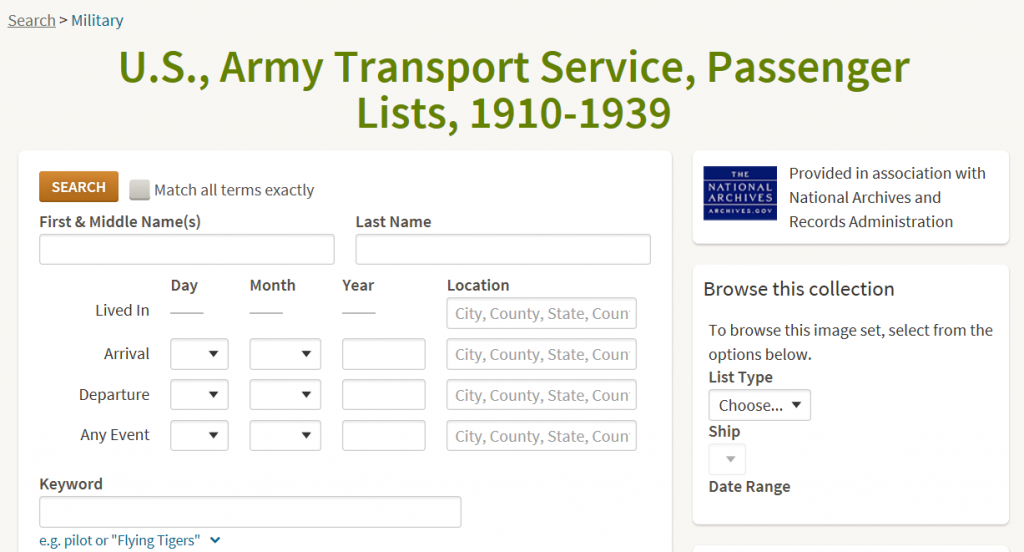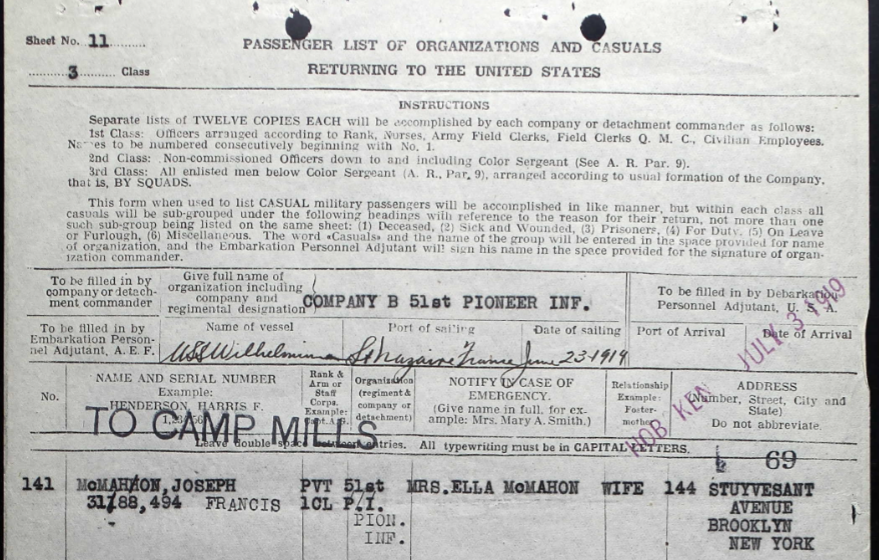WWI in the Passenger Lists of the U.S. Army Transport Service (Part I)
In my lectures, I recommend searching for Ancestry.com’s military records from the Military Records Landing Page.

When you search from the regular search page, the results are from the most popular 10% of all their databases. Searching from the Military Landing Page, I came across records from: U.S., Army Transport Service, Passenger Lists, 1910-1939. The record in this database give you the name of the person traveling on U.S. Army Transport plus the military organization, the military serial number and whom to notify in case of emergency and his/her relationship to the passenger. The people who would be notified were wives, mothers, father, grandmothers, cousins and friends and their addresses were listed in the record.
This is another possible path to find the military organization and service number of your WWI ancestor! When your ancestor has a common name, you can use the contact information and address to verify you have the correct person in the record.
In the records, you may find family members or foreign personnel that were transported by the Army. These are from the Records of the Office of the Quartermaster General, 1774-1985, Record Group 92, held at NARA in College Park.
Searching the Database
It is always a good idea to read the information about the specific database to learn if there is a reason you cannot locate an individual. When you search an individual database on Ancestry.com, that information is available on its search page. Reading all that is the hardest thing to do when the empty search boxes beckon you, but at least you know where to find the information if you need it.
From the database page, you can search using a variety of fields, or browse starting with the List Type (Outgoing or Incoming).

From this page for one individual database page, you can search or browse through the collection. You can narrow down your search to one database, and alter your search terms to find your ancestor’s record.
In addition to a name and dates, there are useful fields to search this database.

Searching for my specific soldier’s name yielded multiple results, but using his military service number tuned right in to his record. This documented his return from France on the S. S. Wilhemina. I checked the box for “Exact” and only one record was returned.

The actual record is below.

Finding his way over to France proved a little more challenging. I had to uncheck the exact box for his service number.
One thing to try is to use a space after a name beginning with “Mc” (or O’, Mac or Van), but that did not help. It was clear his name had been misrecorded or misindexed.
Since I knew it, I added the ship’s name, and added his military organization in the Keyword field: “51st Pioneer Infantry”.

This proved successful.

His name was indexed correctly; it was misspelled in the original record.
![]()
Always remember to select and copy the source citation information.

Reading through these records is interesting. There are notations about soldiers who were transferred between units, hospitalilzed, and those who were A.W.O.L. (Absent With Out Leave) before boarding the ship to Europe. The experience of training, then going off to war had to be overwhelming. For some immigrants, like my Grandfather, it must have seemed surreal to head back to the continent they had left behind a few, or many, years ago.
These records are a great resource for building a timeline of your WWI ancestor’s service. They are invaluable for connecting that ancestor to a family member and a place.
The next post will cover finding information about a specific military organization traveling in this set of records.



